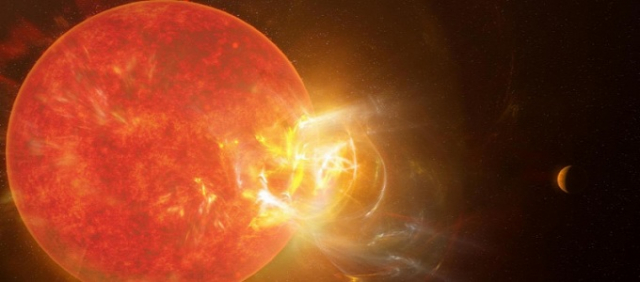Gyurkity Péter
Extrém tevékenységgel pusztít a szomszédos csillag

A Proxima Centauri drasztikus módon bombázza kísérői felszínét.
A Naphoz legközelebb eső szomszédos csillagról, annak kísérőiről az elmúlt években mi is több alkalommal írtunk, a szakemberek ugyanis több távcső (és távcsőrendszer) segítségével is figyelik a számunkra legérdekesebb objektumokat. Eleinte még tápláltak reményeket az élet jelenlétével kapcsolatban, 2018-ban azonban ezt már egyértelműen cáfolták, most pedig a naptevékenység extrém jellegére hívják fel a figyelmet.
A kutatócsoport tagjai ezúttal is a chilei ALMA-antennahálózat, valamint a Hubble bevonásával regisztrálták az újabb fejleményeket. Az április folyamán közzétett hivatalos bejelentésben arról olvashatunk, hogy egy 2019 májusi eseményről van szó, amelynek során a Proxima Centauri esetében hatalmas flert rögzítettek, a milliméteres tartományban a csillag fényessége alig néhány másodperc alatt az ezerszeresére nőtt, viszont az ultraibolya tartományban kutató Hubble ennél is nagyobb eltérést mért, eszerint a fényesség tizennégyezerszer volt nagyobb a szokásosnál. Ez persze a csillag körül keringő bolygókat, azok felszínét is érinti, egy egészen brutális bombázás formájában, aminek kapcsán kiemelik, hogy a fenti jelenség százszor erősebb annál, amit a Napnál valaha is láttunk.
Számunkra leginkább a Proxima b számít érdekes égitestnek, ez ugyanis egy, a Föld méretéhez fogható, szilárd felszínnel rendelkező bolygó, míg a Proxima c egy mini-Neptunusz. Előbbi a lakható zónában mozog, viszont ez jóval közelebb helyezkedik el a csillaghoz, mint saját rendszerünk esetében, emiatt a bolygó alig 11 nap alatt kerüli meg azt. A napszél ereje többek között ebből kifolyólag is jóval erősebb az általunk megszokottnál, az eltérés ebben a tekintetben kétezerszeres, ami nyilván nem túl kedvező hatást fejt ki a felszínre. Tekintettel arra, hogy a két csillag nagyjából azonos korú, a Proxima Centauri évmilliárdok óta bombázhatja kísérőinek felszínét, így az élet jelenléte az amúgy ideális pozíció ellenére sem túl valószínű.
A csillagászok azt remélik, hogy több műszer egyidejű alkalmazásával ezen hatás részleteit figyelhetik majd meg, jobban felmérve, hogy pontosan mit eredményeznek ezen kitörések.
A Naphoz legközelebb eső szomszédos csillagról, annak kísérőiről az elmúlt években mi is több alkalommal írtunk, a szakemberek ugyanis több távcső (és távcsőrendszer) segítségével is figyelik a számunkra legérdekesebb objektumokat. Eleinte még tápláltak reményeket az élet jelenlétével kapcsolatban, 2018-ban azonban ezt már egyértelműen cáfolták, most pedig a naptevékenység extrém jellegére hívják fel a figyelmet.
A kutatócsoport tagjai ezúttal is a chilei ALMA-antennahálózat, valamint a Hubble bevonásával regisztrálták az újabb fejleményeket. Az április folyamán közzétett hivatalos bejelentésben arról olvashatunk, hogy egy 2019 májusi eseményről van szó, amelynek során a Proxima Centauri esetében hatalmas flert rögzítettek, a milliméteres tartományban a csillag fényessége alig néhány másodperc alatt az ezerszeresére nőtt, viszont az ultraibolya tartományban kutató Hubble ennél is nagyobb eltérést mért, eszerint a fényesség tizennégyezerszer volt nagyobb a szokásosnál. Ez persze a csillag körül keringő bolygókat, azok felszínét is érinti, egy egészen brutális bombázás formájában, aminek kapcsán kiemelik, hogy a fenti jelenség százszor erősebb annál, amit a Napnál valaha is láttunk.
Számunkra leginkább a Proxima b számít érdekes égitestnek, ez ugyanis egy, a Föld méretéhez fogható, szilárd felszínnel rendelkező bolygó, míg a Proxima c egy mini-Neptunusz. Előbbi a lakható zónában mozog, viszont ez jóval közelebb helyezkedik el a csillaghoz, mint saját rendszerünk esetében, emiatt a bolygó alig 11 nap alatt kerüli meg azt. A napszél ereje többek között ebből kifolyólag is jóval erősebb az általunk megszokottnál, az eltérés ebben a tekintetben kétezerszeres, ami nyilván nem túl kedvező hatást fejt ki a felszínre. Tekintettel arra, hogy a két csillag nagyjából azonos korú, a Proxima Centauri évmilliárdok óta bombázhatja kísérőinek felszínét, így az élet jelenléte az amúgy ideális pozíció ellenére sem túl valószínű.
A csillagászok azt remélik, hogy több műszer egyidejű alkalmazásával ezen hatás részleteit figyelhetik majd meg, jobban felmérve, hogy pontosan mit eredményeznek ezen kitörések.